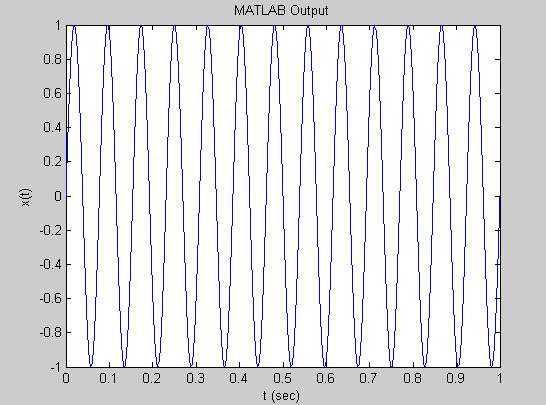(New page: ==Problem with MATLAB Code== <pre> F0 =13; T0 =1/F0; Ts = 0.07; t = 0:Ts:13*T0; x = real(exp(j*(2*pi*F0*t-pi/2))); plot(t,x) </pre> The problem with the above MATLAB code is that the ...) |
|||
| (2 intermediate revisions by the same user not shown) | |||
| Line 9: | Line 9: | ||
</pre> | </pre> | ||
| − | The problem with the above MATLAB code is that the time vector interval | + | The problem with the above MATLAB code is that the time vector interval Ts = 0.07 sec is too small compared to the period of the signal which is 1/13 <math>\approx</math> 0.0769 sec. This bug can be fixed by letting Ts = 0.001 sec: |
| + | |||
| + | <pre> | ||
| + | F0 =13; | ||
| + | T0 =1/F0; | ||
| + | Ts = 0.001; | ||
| + | t = 0:Ts:13*T0; | ||
| + | x = real(exp(j*(2*pi*F0*t-pi/2))); | ||
| + | plot(t,x) | ||
| + | </pre> | ||
| + | |||
| + | The result is the desired graph of 13 cycles: | ||
| + | |||
| + | [[Image:13HzCorrect_ECE301Fall2008mboutin.JPG]] | ||
Latest revision as of 13:13, 11 September 2008
Problem with MATLAB Code
F0 =13; T0 =1/F0; Ts = 0.07; t = 0:Ts:13*T0; x = real(exp(j*(2*pi*F0*t-pi/2))); plot(t,x)
The problem with the above MATLAB code is that the time vector interval Ts = 0.07 sec is too small compared to the period of the signal which is 1/13 $ \approx $ 0.0769 sec. This bug can be fixed by letting Ts = 0.001 sec:
F0 =13; T0 =1/F0; Ts = 0.001; t = 0:Ts:13*T0; x = real(exp(j*(2*pi*F0*t-pi/2))); plot(t,x)
The result is the desired graph of 13 cycles:


